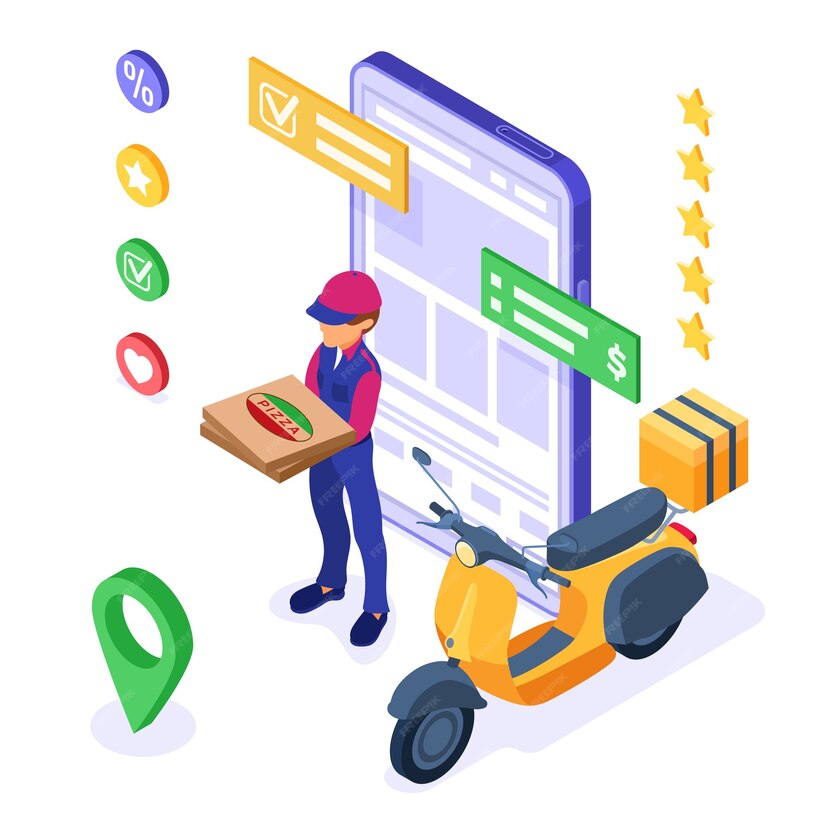Launching a delivery service app might be a successful endeavor, given the growing need for efficiency and convenience. There’s never been a greater need for quick, dependable delivery services—from groceries and meals to parcels and medications. Here is a thorough guide on how to launch your own delivery service app if you’re thinking about getting into this expanding business.
1. Research and Understand the Market
It is essential to carry out comprehensive market research before beginning development. The first stages include knowing your target market, identifying market gaps, and researching your competition.
- Target Audience: Determine who your app will serve. Are you focusing on urban professionals who need quick food deliveries, or is your target market suburban families who require grocery deliveries? Knowing your audience helps tailor your app to meet their specific needs.
- Market Gaps: Determine the gaps in the current delivery services. This can take the form of expanded product selection or quicker delivery timeframes. Filling in these gaps will make your app more unique.
- Competitor Analysis:Examine current delivery applications to learn about their advantages and disadvantages. This will enable you to create a more competitive product by providing you with insights into what works and what doesn’t.
2. Define Your Business Model
An effective app starts with a well-defined business plan. How you make money and maintain your company will depend on your business plan.
- Commission-Based: Take a set amount on every purchase made using your application. Uber Eats and DoorDash, two popular meal delivery apps, use this approach frequently.
- Subscription-Based: Offer a subscription service where users pay a monthly or annual fee for unlimited deliveries.
- Freemium: Provide basic delivery services for free, with premium features available for a fee.
- Delivery Fees: Charge a delivery fee based on distance, time, or order size.
3. Design and Develop the App
The success of your app will be greatly influenced by its functionality and design. Your app should be visually beautiful, easy to use, and full of features that cater to the demands of your users.
- User Interface (UI): Make sure the design of your app is simple and easy to use. A difficult-to-use interface may turn off users.
- Core Features: Order tracking, several payment methods, push alerts, and customer service are all necessary elements. The user experience can be improved with extra features like delivery scheduling, reviews and ratings, and reward programs.
- Technology Stack: Select the appropriate technology stack for the database management, frontend, and backend of your application. Popular options include Node.js for backend development, MongoDB for database administration, and React Native for cross-platform development.
- MVP Development: For early consumers, test your concept with a Minimum Viable Product (MVP). An MVP allows you to get feedback and make changes before a full-scale launch by only including the features that are necessary to fix the main issue.
4. Set Up the Logistics and Supply Chain
Logistics is the backbone of any delivery service. Efficient logistics and supply chain management ensure that deliveries are made on time and at the lowest possible cost.
- Partnerships: Form alliances with nearby companies, eateries, or retail establishments to guarantee a consistent flow of goods for delivery.
- Fleet Management: Decide on whether to work with outside delivery providers or maintain your network of deliveries. Although they cost more to operate, internal fleets give you more control. Although they might be less expensive, third-party providers might not be able to offer as quick or high-quality of delivery.
- Routing and Scheduling: Implement technology that optimizes delivery routes and schedules to reduce delivery times and costs.
5. Ensure Legal Compliance
Starting a delivery service app involves navigating various legal requirements. It’s essential to ensure your business complies with all local, state, and federal regulations.
- Licenses and Permits: Obtain all necessary business licenses and permits. This may vary depending on the type of products you’re delivering.
- Data Privacy: Ensure your app complies with data privacy laws, such as the General Data Protection Regulation (GDPR) or the California Consumer Privacy Act (CCPA).
- Contracts: Draft contracts for partnerships, whether with restaurants, stores, or delivery drivers, to protect your business interests.
6. Launch and Market Your App
With your app ready, it’s time to launch and attract users. A well-executed marketing strategy can make or break your app’s success.
- Pre-Launch: Generate buzz before your app goes live through social media teasers, influencer partnerships, and early access offers.
- SEO and ASO: Optimize your app for search engines (SEO) and app stores (ASO) to increase visibility. Use relevant keywords, high-quality images, and engaging descriptions.
- Social Media Marketing: Leverage social media platforms to reach your target audience. Engage with potential users through posts, stories, and ads.
- Referral Programs: Encourage users to refer your app to others by offering incentives such as discounts or free deliveries.
7. Monitor, Improve, and Scale
Once your app is live, continuous monitoring and improvement are crucial. Gather user feedback, track key performance indicators (KPIs), and make necessary updates.
- User Feedback: Regularly solicit feedback from users to identify pain points and areas for improvement.
- Performance Metrics: Track metrics such as user retention rate, delivery times, and customer satisfaction to gauge your app’s performance.
- Scaling: As your app becomes more popular, think about growing your company by entering new areas, introducing new features, or hiring more delivery personnel.
Conclusion
Launching an application for delivery services is an exciting and possibly profitable business opportunity. You can build a successful delivery service that satisfies the demands of the modern, fast-paced market by following these steps: conducting extensive research, defining a clear business model, developing a user-friendly app, setting up efficient logistics, guaranteeing legal compliance, launching effectively, and continuously improving. Customers seeking efficiency and convenience in their daily lives may turn to your app as their go-to option with the correct approach and implementation.




